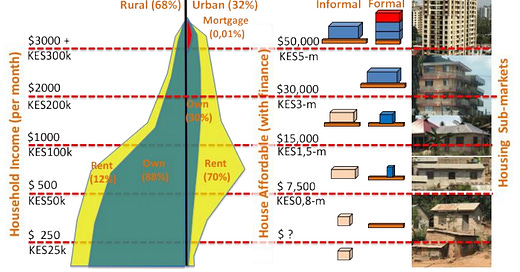economics and ROI on reflective coating
breaking down the costs and incentives of applying a 1-2 mm reflective coating to houses in Kenya.
For a 1-2 mm coating on a house with an external surface area between 100 and 150 square meters, we'll find the volume of each component in 0.125 m³ of the mixture, by multiplying the proportion by the total volume:
Whitewash: 0.5 * 0.125 m³ = 0.0625 m³
Binding agent: 0.25 * 0.125 m³ = 0.03125 m³
Sand: 0.125 * 0.125 m³ = 0.015625 m³
Reflective materials: 0.125 * 0.125 m³ = 0.015625 m³
Now, we'll calculate the cost for 0.125 m³ of the mixture using the volumes and costs of each component obtained earlier:
Whitewash (0.0625 m³ of hydrated lime + 0.0625 m³ of water): (0.0625 * KES 132,000) + (0.0625 * KES 50) = KES 8,253.75
Binding agent (0.03125 m³): 0.03125 * KES 1,000 = KES 31.25
Sand (0.015625 m³): 0.015625 * KES 3,200 = KES 50
Reflective materials (0.015625 m³): 0.015625 * KES 4,000 = KES 62.50
Adding up all the components, we’ll get the total cost for 0.125 m³ of the mixture: KES 8,253.75 (whitewash) + KES 31.25 (binding agent) + KES 50 (sand) + KES 62.50 (reflective materials) = KES 8,397.50
So, the estimated cost for 0.125 m³ of the mixture would be approximately KES 8,397.50.
The cost of applying the solution to a house is at KES 8,397.50 = 61.91 USD (unsubsidized by the government for 0.125cm^3 of solution which is enough for a coating of 1 mm around a house with an external surface area of 125 m^2).
Energy savings: Since air conditioning is less common in Kenya, we'll focus on the savings resulting from reduced use of fans. A typical fan consumes around 50W. If a household runs a fan for an additional 4 hours per day during the hot months (let's assume 4 months per year) due to the whitewash's cooling effect, the energy savings would be:
50W x 4 hours/day x 30 days/month x 4 months/year = 24,000 Wh = 24 kWh/year
The average cost of electricity in Kenya is about KES 18 per kWh. So, the annual energy savings would be:
24 kWh/year x KES 18/kWh = KES 432/year = 3.18 USD
Structural stability and durability: We'll assume that the whitewash mixture still results in a 75% reduction in the likelihood of a house collapsing due to heat-related issues. With a 20% chance of a house collapsing in 5 years, the enhanced durability provided by the whitewash mixture reduces the probability to 5% (75% reduction). The expected savings in rebuilding costs over 5 years would be:
Original risk: 20% x KES 1,000,000 = KES 200,000 Reduced risk: 5% x KES 1,000,000 = KES 50,000 Savings: KES 200,000 - KES 50,000 = KES 150,000
Annualized savings: KES 150,000 / 5 years = KES 30,000/year
Total value created: Combining the energy savings and the savings from improved structural stability, we get a total annual value of:
KES 432 (energy savings) + KES 30,000 (structural stability savings) = KES 30,432/year
The annualized cost of the investment remains the same: KES 1,679.50/year.
Now, we can calculate the value created per KES invested with the updated figures:
Value created per KES invested = Total annual value created / Annualized investment cost = KES 30,432 / KES 1,679.50 ≈ 18.12
This means that for every KES invested in applying this solution to houses in Kenya, approximately KES 18.12 of value is created through energy savings and improved structural stability.
$1 spent by consumer creates $18.12 in value.
if government subsidizes 50% of the cost → $1 spent by consumer creates $36.24 in value
government subsidization
Let's assume the Kenyan government recognizes the potential benefits of the whitewash solution and decides to subsidize a part of the costs to promote its use, aiming to reduce the budget allocated to rebuilding houses due to climate disasters. The government plans to redirect a certain percentage of their disaster relief budget to support the adoption of this solution.
Current cost of rebuilding houses: The Kenyan government currently spends KES 300 million per year on rebuilding houses due to climate disasters.
Government subsidy: The government decides to allocate 10% of the current disaster relief budget to subsidize the whitewash solution. This means they will provide KES 30 million (10% of KES 300 million) per year as subsidies to homeowners.
Subsidy per household: The cost of applying the whitewash solution to a house is KES 8,397.50. The government could choose to cover a portion of this cost, say 50%, to incentivize homeowners to use the whitewash solution. This would result in a subsidy of KES 4,198.75 per household.
Number of households benefiting from the subsidy: With a total annual budget of KES 30 million for the subsidy, the government can support:
KES 30,000,000 / KES 4,198.75 ≈ 7,145 households per year
Reduced government spending on disaster relief: If the whitewash solution significantly reduces the likelihood of houses collapsing due to excess heat (as calculated previously), the government could see a considerable reduction in the number of houses needing to be rebuilt. As the solution is adopted more widely, the government would be able to allocate a smaller portion of their budget to disaster relief, redirecting those funds to other essential services or infrastructure projects.




